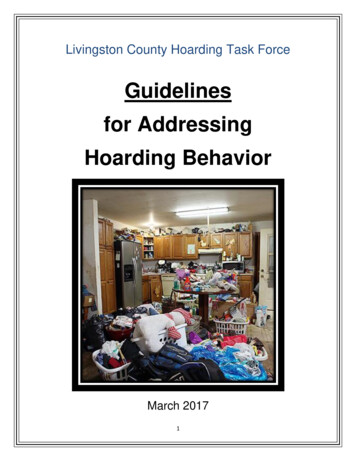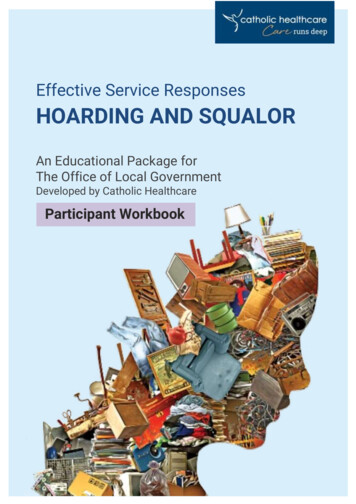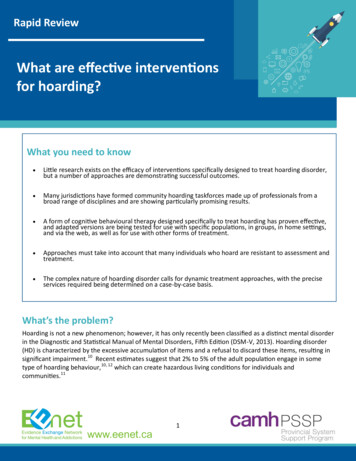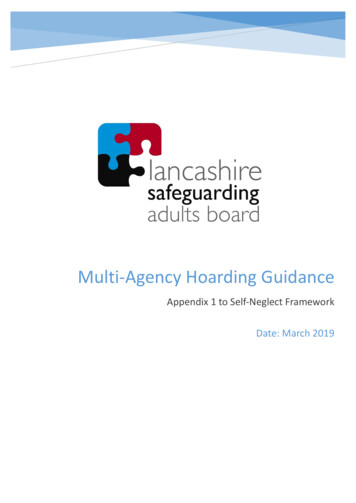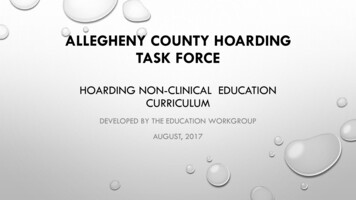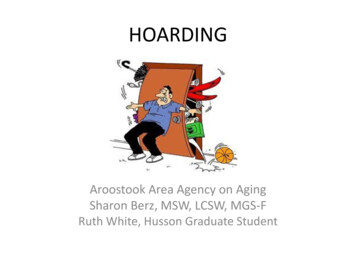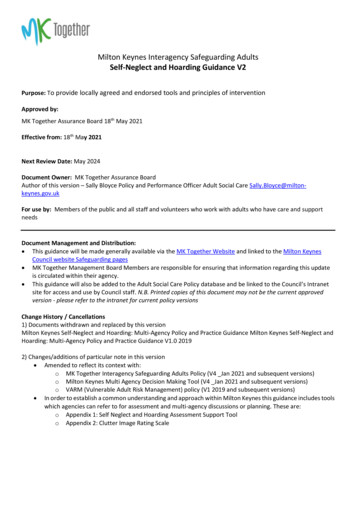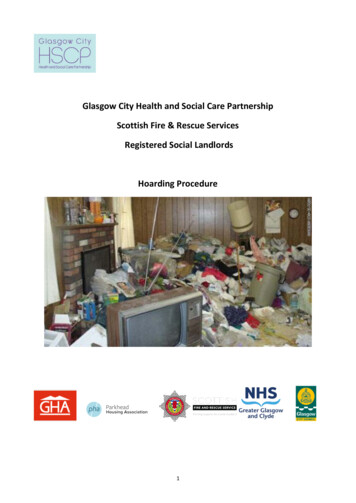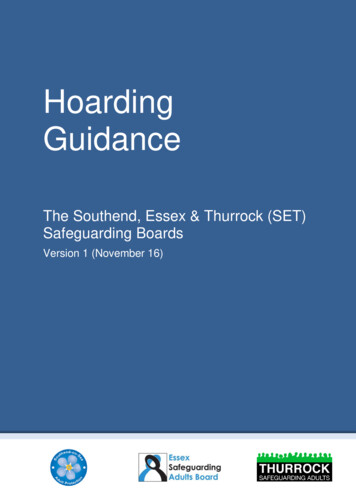
Transcription
HoardingGuidanceThe Southend, Essex & Thurrock (SET)Safeguarding BoardsVersion 1 (November 16)1
Document Control SheetTitle:Multi-Agency Hoarding GuidancePurpose:A guide for local partnerships and agencies in SouthendEssex and Thurrock how to deal with HoardingType:Operational policy and guidanceTarget Audience:All professionals working in Southend, Essex and ThurrockDate approved:November 2016Review Date:This replaces:n/aThis should be readalongside:This Policy is compliant with all relevant legislation at thetime of publication and adheres to the current SETSafeguarding Adults Guidelines and SET SafeguardingLeads / Authors:Paula Ward (ESAB)
PageNumberINDEX1Introduction32Who does the guidance apply to?33Aims of guidance34Definition of hoarding35General characteristics of hoarding36What is hoarding disorder?47Types of hoarding58Information sharing59Fire safety610Legal powers and duties711Mental capacity912Hoarding Insight characteristics1013Early intervention1114The referral process including referral pathway111) Safeguarding children2) Safeguarding AdultsAppendices:1) Practitioners hoarding assessment2) Clutter image rating tool3) Questions for practitioners4) Assessment tool guidelines5) Agency actions – roles and responsibilities6) Multi agency meeting agenda template7) Risk assessment form and management form8) Useful contactsThis guidance has been adapted from The London Borough of Merton Hoarding Protocol.1. Introduction2
This guidance sets out an understanding of the issues of hoarding and details thepath a practitioner should take to risk assess and safeguard the individual using anoutcome focused, solution based model. This guidance should be read alongside theSET adult safeguarding adult guidelines and the SET safeguarding childrenprocedures.2. Who does the guidance apply to?This guidance applies to all those who may come across hoarding as part of theirday to day duties. There is an expectation that everyone engages fully in partnershipworking to achieve the best outcome for the adult and any child(ren), while meetingthe requirements and duties of individual agencies.3. Aims of guidanceThe aims of this guidance are to: Investigate and share information on the problems related to hoarding fromdifferent professional and community perspectives. Dealing with incidents inan evidence based, structured, systematic, co-ordinated and consistent way. Develop “informal” multi-agency solutions which maximise the use of existingservices and resources and which may reduce the need for compulsorysolutions. Ensure that when formal solutions are required, there is a process forplanning solutions tailored to meet the needs of the adult(s) and/or anychild(ren). Possible solutions include identifying and mobilising the supportnetwork, universal services, professional support and monitoring, propertyrepairs and permanent and temporary re-housing. To establish best practice and improve knowledge of legislation that relates tohoarding behaviour.4. Definition of hoardingHoarding is the excessive collection and retention of any material to the point that itimpedes day to day functioning (Frost & Gross, 1993). Pathological or compulsivehoarding is a specific type of behaviour characterised by: Acquiring and failing to throw out a large number of items that would appear tohold little or no value and would be considered rubbish by other people; Severe “cluttering” of the adults home so that it is no longer able to function as aviable living space; Significant distress or impairment of work or social life (Kelly 2010).5. General characteristics of hoarding3
Fear and anxiety: compulsive hoarding may have started as a learntbehaviour or following a significant event such as bereavement. The adulthoarding believes buying or saving things will relieve the anxiety and fear theyfeel. The hoarding effectively becomes their comfort blanket. Any attempt todiscard hoarded items can induce feelings varying from mild anxiety to a fullpanic attack with sweats and palpitations. Long term behaviour pattern: possibly developed over many years, ordecades, of “buy and drop”. Collecting and saving, with an inability to throwaway items without experiencing fear and anxiety. Excessive attachment to possessions: people who hoard may hold aninappropriate emotional attachment to items. Indecisiveness: people who hoard struggle with the decision to discard itemsthat are no longer necessary, including rubbish. Unrelenting standards: people who hoard will often find faults with others,require others to perform to excellence while struggling to organisethemselves and complete daily living tasks. Socially isolated: people who hoard will typically alienate family and friendsand may be embarrassed to have visitors. They may refuse home visits fromindividuals including professionals, in favour of office based appointments ordeclining support / services. Large number of pets: people who hoard may have a large number ofanimals that can be a source of complaints by neighbours. They may be aself-confessed “rescuer of strays”. Mentally competent: people who hoard are typically able to make decisionsthat are not related to the hoarding. Extreme clutter: hoarding behaviour may prevent several or all the rooms ofan adults’ property from being used for its intended purpose. Churning: hoarding behaviour can involve moving items from one part of anadult’s property to another, without ever discarding anything. Self-care: an adult who hoards may appear unkempt and dishevelled, due tolack of toileting or washing facilities in their home. However, some people whohoard will use public facilities, in order to maintain their personal hygiene andappearance. Poor insight: an adult who hoards will typically see nothing wrong with theirbehaviour and the impact it has on them and others.6. What is hoarding disorder?4
The Care Act (2014) statutory guidance includes self-neglect as a new type ofabuse. Within this it states this covers a wide range of behaviour neglecting to carefor one’s personal hygiene, health or surroundings and includes behaviour such ashoarding.The Royal College of Psychiatrists states that hoarding can be an illness in its ownright, known as hoarding disorder. Hoarding can also be part of another healthproblem; Physical illness, dementia, depression, alcohol and drug misuse,schizophrenia, bipolar disorder, learning disability or obsessive compulsive disorderIt is important to remember that not all hoarders have mental health issues andwould not meet the criteria in an assessment. Hoarding disorder is distinct from theact of collecting, and is also different from people whose property is generallycluttered or messy. It is not simply a lifestyle choice. The main difference between ahoarder and a collector is that hoarders have strong emotional attachments to theirobjects which are well in excess of their real value.Hoarding does not favour a particular gender, age, ethnicity, socio-economic status,educational / occupational history or tenure type. Anything can be hoarded, invarious areas including the adult’s property, garden or communal areas. However,commonly hoarded items include but are not limited to: Clothes Newspapers, magazines or books Bills, receipts or letters Food and food containers Animals Medical equipment Collectibles such as toys, video, DVD, or CDs Items that others may consider rubbish7. Types of hoardingThere are three types of hoarding: Inanimate objects: This is the most common. This could consist of one typeof object or a collection of a mixture of objects such as old clothes,newspapers, food, containers or papers. Animal hoarding: Animal hoarding is on the increase. This is the obsessivecollecting of animals, often with an inability to provide minimal standards ofcare. The hoarder is unable to recognise that the animals are or may be atrisk because they feel they are saving them. In addition to an inability to care5
for the animals in the home, people who hoard animals are often unable totake care of themselves. The homes of animal hoarders are often eventuallydestroyed by the accumulation of animal faeces and infestation by insects.Data hoarding: This is a new phenomenon of hoarding. There is littleresearch on this matter and it may not seem as significant as inanimate andanimal hoarding, however people that do hoard data could still present withsame issues that are symptomatic of hoarding. Data hoarding could presentwith the storage of data collection equipment such as computers, electronicstorage devices or paper. A need to store copies of emails, and otherinformation in an electronic format.8. Information sharingPractitioners must always seek the consent of the adult at the heart of the concernbefore taking action or sharing information. However there may be circumstanceswhen consent cannot be obtained because the adult lacks the capacity to give it butthe best interests of the individual or others at risk of harm demand action. In thesecases Mental Capacity Act guidance should be followed.In some cases, where an adult refuses consent, information can still lawfully beshared if it is in the public interest to do so. This may include protecting someonefrom serious harm or preventing crime and disorder. The key factors in decidingwhether or not to share confidential information are: Necessity – sharing is likely to make an effective contribution to preventingthe risk, and; Proportionality – the public interest in sharing outweighs the interest inmaintaining confidentiality.If there is any doubt about whether to share information, advice should be obtainedfrom your organisations safeguarding lead. Things to consider are: Adequate recording if the consent of the adult was obtained and if not why not What information was shared and with whom and how the request wasreceived and recorded, and how the decision was made to share theinformation If third party information is involved if consent was obtained and if not whichexemptions applied All agencies involved must follow the appropriate statutes and guidance.Under the Data Protection Act 1998, organisations have the responsibility to ensure6
that personal information is processed lawfully and fairly. All adults have a right toview any information held about them. Practitioners should consider this when theyare recording information about the adult.All agencies need to ensure that when it is decided it is appropriate to shareinformation about hoarded properties with local fire brigades, and that this is beingdone on a need to know basis. All information should be transferred in a secureformat.Where the hoarding behaviour of the adult places a child at risk then this informationshould be shared with Children’s Social Care in the area as appropriate (seeparagraph 12 below).9. Fire safetyHoarding may pose a significant fire risk to both the people living in the hoardedproperty and those living nearby. Where a hoarded property is identified regardlessof the risk rating, adults need to be advised of the increased fire risk and identify asafe exit route. Appropriate professional fire safety advice must be sought.Information should be shared with appropriate emergency services by alerting themto hoarded properties. This will allow crews to respond appropriately. Onceproperties are cleared the information must be updated. A fire safety checkundertaken by Essex County Fire and Rescue Service may be appropriate (see linkfor more information).10. Legal powers and dutiesThe Local Authorities (LA), including, where appropriate, the County Council, DistrictCouncils and Unitary Authorities will always try and work with an adult to identify asolution to a hoarded property, and professionals should contact the environmentalwaste services department of the local authority so they can be aware of the localauthorities own procedures for waste collection and other local facilities available.However in cases were the adult is not willing to co-operate the LA can serve noticeon the owner or occupier.As mentioned above, an adult who is hoarding may be subject to the Care Act 2014,the Mental Capacity Act 2005 and/ or the Mental Health Act 1983. These arecomplex Acts but a selection of the key duties and powers are included below:The Care Act 2014Section 6: Co-operationLocal authorities should co-operate in cases such as this. Specifically this will meanthat the County Council and the District Council should work in tandem with eachother where appropriate.Section 9: Assessing an adult’s needs for care and supportThe offer of an assessment should be made to the adult because it will likely appearto the local authority that the adult may have care and support needs.7
Section 42: SafeguardingHoarding may qualify as self-neglect and also pose a safeguarding risk to others, forexample family or carers.Please note that this Act does not provide a right of entry.Mental Capacity Act 2005The principles have been set out above in section 8.Section 4: Best InterestsIf a hoarder has been assessed as lacking capacity regarding their hoarding then abest interests decision can be taken on their behalf. Depending on the situation, anapplication may be required to be made to the Court of Protection, please seek legaladvice.Please note that this Act does not provide a right of entry.Mental Health Act 1983Section 2: Admission for AssessmentThis section would allow a hoarder to be admitted to hospital against their will if: They suffer from a mental disorder to the degree which warrants theirdetention in hospital for a limited period of time for the purposes ofassessment; and They ought to be detained for their own protection or the protection of othersThere is a strict legal procedure for this and it would only be applicable in extremecircumstances. Please note there is a power of entry by the police on grant of awarrant. The warrant is only granted if an Approved Mental Health Professional(AMHP) presents the Magistrate with the relevant information. It is at this point thatthe warrant can be issued and Police can enter with the AMHP.The following legislation is available to Environmental Health Officers.Public Health Act 1936Section 79: Power to require removal of noxious matter by occupier ofpremisesThis is seldom used as there is more appropriate legislation. If it is used it wouldgenerally be in respect of outdoor areas. Allows the cost to be recharged.Section 83: Cleansing of filthy and/or verminous premisesWhere any premises is found to be;a) In such a filthy or unwholesome condition as to be prejudicial to health; orb) verminous (relating to rats, mice other pests including insects, their eggs andlarvae)8
Then the LA can serve a notice requiring clearance of materials and objects that arefilthy, cleansing of surfaces, carpets etc. within a specified time period. This isgenerally a minimum of 21 days. If not complied with, Environmental Health (EH)can carry out works in default and recharge the costs. Appeal provisions are inplace.Section 84: Cleansing or destruction of filthy or verminous articlesAny article that is so filthy as to need cleansing or destruction in order to preventinjury to persons in the premises or is verminous. The LA can serve notice requiringthe identified article to be cleansed, purified, disinfected or destroyed at theirexpense. This section is also seldom used, if it were to be used it would be inconjunction with action taken under section 83.Prevention of Damage by Pests Act 1949Section 4: Power of LA to require action to prevent or treat rats and miceNotice may be served on the owner or occupier of land/ premises where rats and/ormice are or may be present due to the conditions at the time. The notice served onthe owner or occupier would specify a reasonable period of time in which to carry outreasonable steps to eradicate the rats/mice from the land/premises. This could entailpest control treatment, requirement to remove materials that may feed or harbourthem and carry out necessary structural works. The LA may carry out works indefault if the Notice is not complied with and charge for this. However there is nopower of entry available under this section, so if refused access to carry out works indefault the LA are unable to enter.Environmental Protection Act 1990Section 79: Statutory nuisances and inspections therefor.Statutory Nuisances (SN) are defined in Section 79 of the Act and include thefollowing:(a) any premises in such a state as to be prejudicial to health or a nuisance(c) fumes or gases emitted from [private dwellings] premises so as to be prejudicialto health or a nuisance(e) any accumulation or deposit which is prejudicial to health or a nuisance(f) any animal kept in such a place or manner as to be prejudicial to health or anuisanceIt is the duty of every local authority to cause its area to be inspected from time totime to detect any statutory nuisances which ought to be dealt with under section 80and, where a complaint of a statutory nuisance is made to it by a person living withinits area, to take such steps as are reasonably practicable to investigate thecomplaint.‘Nuisance’ means something which interferes with another’s land (or more rarely thepopulation at large).Section 80: Summary proceedings for statutory nuisances.9
Where a local authority is satisfied that a statutory nuisance exists, or is likely tooccur or recur, in the area of the authority, the local authority shall serve a notice(“an abatement notice”) imposing all or any of the following requirements—(a) requiring the abatement of the nuisance or prohibiting or restricting its occurrenceor recurrence;(b) requiring the execution of such works, and the taking of such other steps, as maybe necessary for any of those purposes;and the notice shall specify the time or times within which the requirements of thenotice are to be complied with. Appeal provisions are in place. Environmental Health(EH) can also carry out works in default and recharge the costs.Anti-Social Behaviour, Crime & Policing Act - powers to control hoarding where itis likely to have a detrimental effect on the quality of life to others in the locality.11. Mental capacityThe Mental Capacity Act 2005 provides a statutory framework for people who lackcapacity to make decisions for themselves. The Act has 5 statutory principles andthese are the values which underpin the legal requirements of the Act. They are:1. A person must be assumed to have capacity unless it is established that theylack capacity.2. A person is not to be treated as unable to make a decision unless all practicalsteps have been taken without success.3. A person is not to be treated as unable to make a decision merely becausethey make an unwise decision.4. An act done or decision made, under this act for or on behalf of a person wholacks capacity must be done, or made in his or her best interests.5. Before the act is done, or the decision is made, regard must be had towhether the purpose for which it is needed can be as effectively achieved in away that is less restrictive of the person’s rights and freedom of action.To view the Mental Capacity Act Policy, Guidance and Form please click here.Should a capacity assessment be considered, this is an assessment of capacity forwhether the client as capacity to access help for their hoarding – so, does the clientunderstand they have a problem with hoarding?; is the client able to weigh up thealternative options? eg being able to move around their accommodation unhindered,being able to sleep in their bed, take a bath, cook in their kitchen, sit down on achair/sofa? (this list is not exhaustive!); can the client retain the information given tothem? (eg, if the accommodation is cleared, you would be able to move around youraccommodation etc); can the client communicate their decision? It is essential thatany capacity assessment is clearly documented on case records.10
12. Hoarding Insight characteristicsThe following is a guide on whether the adult has insight into their hoardingbehaviour.Good or fair insight: The adult recognises that hoarding-related beliefs andbehaviours (relating to difficulty discarding items, clutter or excessive acquisition) areproblematic. The adult recognises these behaviours in themselves.Poor insight: The adult is mostly convinced that hoarding-related beliefs andbehaviours (relating to difficulty discarding items, clutter or excessive acquisition) arenot problematic despite evidence to the contrary. The adult might recognise astorage problem but has little self-recognition or acceptance of their own hoardingbehaviour.Absent (delusional) insight: The adult is convinced that hoarding-related beliefs andbehaviours (relating to difficulty discarding items, clutter or excessive acquisition) arenot problematic despite evidence to the contrary. The adult is completely acceptingof their living environment despite it being hoarded and possibly a risk to health.Detached with assigned blame: The adult has been away from their property for anextended period. The adult has formed a detachment from the hoarded property andis now convinced a 3rd party is to blame for the condition of the property. Forexample a burglary has taken place, squatters or other household members.13. Early intervention workEarly intervention means getting involved early or as soon as possible to tackle anyemerging issues by providing the right support at the right time. In most cases, thisis achieved by services working together and may take the form of a multi-agencymeeting involving the individual.14. The referral process (see flowchart)Hoarding is a complex condition and requires a multiagency response. Anyprofessional working with an individual who may have or appear to have a hoardingcondition should ensure they complete the Practitioners Hoarding Assessment anduse the clutter image rating to inform decision making. Organisations should gatheras much information as they can prior to making any referral.a) Safeguarding childrenSafeguarding children is everybody’s business and refers to protectingchildren from maltreatment, preventing the impairment of their health ordevelopment and ensuring that they are growing up in circumstancesconsistent with the provision of safe and effective care. Growing up in ahoarded property can put a child at risk by affecting their development and insome cases, leading to the neglect of a child, which is a safeguarding issue.Where a child is residing in a property with a parent/carer who hoards, theinterests of the child are paramount; where there are concerns that the child isat risk of significant harm the child must be referred to Children’s Social Care;11
and where it is identified that there are support needs a referral may be madeto early help. GP’s, Health Visitors and Teachers are a few examples ofprofessionals who are most likely to come into contact with a child growing upin a hoarded house. The needs of the child at risk must come first and anyactions we take reflect this. Please click here for the Southend, Essex andThurrock (SET) Child Protection Procedures which provide guidance. TheLocal Safeguarding Children Boards in Southend, Essex and Thurrock alsoprovide information regarding accessing Early Help and Intervention forchildren and young people (see appendix 8 for website details).b) Safeguarding adultsIncidents that are low risk may be managed outside of safeguarding adultsformal procedures and could potentially be addressed through mechanismssuch as engagement with the adult, i.e. supporting the person to address theirconcerns; engagement with community activities; coordinating a multi-agencymeeting; or access to health care and counselling. It is recognised that not allindividuals that hoard will have care and support needs and an assessmentmay result in a more appropriate pathway being followed to support the adult,instead of the safeguarding process. The initial intervention from Adult SocialCare might be to offer an individual an assessment of their care and supportneeds. Where the risk to the safety and wellbeing of an adult or others arebecoming more critical, a more formal safeguarding adults approach will berequired and a SET SAF1 should be raised (see Safeguarding AdultGuidelines 2015 for more information). The updated Care Act guidance 2016identified that not all cases of self-neglect need to go to a S42 enquiry –perhaps the situation is not impacting on the person’s wellbeing, does notimpact on others, or is not a result of abuse or neglect.c) AnimalsEvidence of animal hoarding at any level should be reported to the RSPCA.Referral processSuspected/known hoarderidentifiedDoes the caseinvolve children?YesIs there evidence ofharm/significantharmNoIs there evidence ofharm/significantharm12
YesComplete a referralto children’s SocialCare(see appendix 8 forcontact details)No evidence ofsignificant harmbut additionalsupport neededRefer to early help(see appendix 8for contact details)No evidence ofsignificant harmbut additionalsupport neededYesComplete areferral to adultSocial Care usingthe SET SAF formOrganisation to liaisewith partner agenciesto seek support for theindividual(Appendix 1 - Practitioners hoarding assessmentPlease note when entering a hoarder’s house you need to understand the risks in which you may face.It is advised to wear thick, protective footwear as you may be exposed to many hazardous objectswithin the residence. Where possible two practitioners should conduct the assessment. Thisassessment should be used to help inform future work, see appendix four for support with actionsfollowing the completion of this assessment. It is essential that a multi-agency approach is taken.Date of assessmentClients nameClients date of birthAddress(incl. postcode)Contact detailsType of dwellingPlease give details ofLandlord/housingassociation (if known)Owner/ Council/ Housing Association/ Private Rental/ OtherNameRelationshipDOB & ageHousehold membersPets & other animalsand any concerns13
Using the Clutter Image scale please provide a description of the hoarding problem:Please consider hallways, stairs and landings, garage, outbuildings, front garden, back garden, side accessPlease refer to the Multi Agency Hoarding Guidance Tool, based on the information providedas wellas roomsthe ishouseabove,what inlevelyour case graded?(presence of human or animal waste, rodents or insects, rotting food, are utilities operational, structuralLevel 1- GreenLevel 2 - OrangeLevel 3 - REDdamage, human faeces, concerns over self neglect, problems with blocked exits, are there combustibles, isthere a fire risk? etc.)Name of referrerName of OrganisationContact details(Telephone and emailaddress)Next action to be takenList agencies involved/referred to with dates &contact namesAdults views or attitudeConcerned for children at theproperty (see section 13 ofthe guidance)Concerned for other adults atthe property (see section 13of the guidance)14
Additional notes:15
Appendix 2 - Clutter image rating toolClutter Image Rating Scale - BedroomPlease select the photo that most accurately reflects the amount of clutter in the room123456789Clutter Image Rating Scale - Lounge16
Please select the photo that most accurately reflects the amount of clutter in the room123456789Clutter Image Rating Scale – Kitchen17
Please select the photo that most accurately reflects the amount of clutter in the room12345678918
Appendix 3 - Questions for practitionersListed below are examples of questions to ask where you are concerned aboutsomeone’s safety in their own home, where you suspect a risk of self- neglect andhoarding. How do you get in and out of your property, do you feel safe living here? Have you ever had an accident, slipped, tripped up or fallen? How did ithappen? How do you move safely around your home ( where the floor is uneven orcovered, or there are exposed wires, damp, rot, or other hazards) Has a fire ever started by accident? Do you have hot water, lighting, heating? How do you get hot water, lighting,heating in here? Do these services work properly? Have they ever been tested? Do you ever use candles or an open flame to heat and light here or cook withcamping gas? How do you manage to keep yourself warm? Especially in winter? When did you last go out in your garden? Do you feel safe to go out there? Are you worried about other people getting in to your garden to try and breakin? Has this ever happened? Are you worried about mice, rats or foxes, or other pests? Do you leave foodout for them? Have you ever seen mice or rats in your home? Have they eaten any of yourfood? Or got upstairs and be nesting anywhere? Can you prepare food, cook and wash up in your kitchen? Do you use your fridge? Can I have look in it? How do you keep things cold inthe hot weather? How do you keep yourself clean? Can I see your bathroom? Are you able touse your bathroom and use the toilet ok? Have a wash, bath? Shower? Can you show me where you sleep and let me see your upstairs rooms? Arethe stairs safe to walk up? ( if there are any) What do you do with your dirty washing? Where do you sleep? Are you able to change your bed linen regularly? Whendid you last change them? Have you got extra covers to put on your bed if youare cold? Are there any broken windows in your home? Any repairs that need to bedone? Because of the number of possessions you have, do you find it difficult to usesome of your rooms? If so which ones? Do you struggle with discarding things or to what extent do you have difficultydiscarding (or recycling, selling, giving away) ordinary things that other peoplewould get rid of?19
Appendix 4 - Assessment tool guidelines1. Propertystructure,services &garden areaLevel 1Clutter image rating 1 - 3 All entrances and exits, stairways, roof spaceand windows accessible. Smoke alarms fitted and functional or referralsmade to Essex Fire a
hoarding. The Royal College of Psychiatrists states that hoarding can be an illness in its own right, known as hoarding disorder. Hoarding can also be part of another health problem; Physical illness, dementia, depression, alcohol and drug misuse, schizophrenia, bipolar disorder, learning disability or obsessive compulsive disorder
